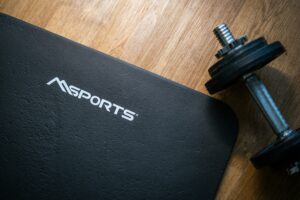The modern professional’s dilemma is real: back-to-back virtual meetings, limited time, and the growing awareness that sitting hunched over a computer for eight hours isn’t doing your body any favors. Your fitness goals don’t have to be another casualty of remote work culture. These five equipment-free workout routines are specifically designed to fit into the brief windows between your Zoom calls, helping you stay energized, focused, and physically healthy throughout your workday.
Each workout takes just 5-15 minutes and requires nothing more than the space around your desk. No gym membership, no equipment, no need to change clothes just effective movements that combat the physical toll of desk work while boosting your energy and mental clarity for the next meeting.
The Science of Micro-Workouts
Research consistently shows that short bursts of physical activity throughout the day can be just as effective as longer, concentrated workout sessions. These “exercise snacks” improve cardiovascular health, enhance cognitive function, and boost mood more effectively than you might expect from such brief sessions.
When you’ve been sitting for extended periods, your circulation slows, your posture suffers, and your energy levels naturally dip. Brief movement breaks reverse these effects rapidly, increasing blood flow to your brain and muscles, improving oxygen delivery, and releasing endorphins that enhance focus and creativity.
The metabolic benefits are equally impressive. Short, intense exercise sessions can elevate your metabolism for hours afterward, a phenomenon known as excess post-exercise oxygen consumption (EPOC). This means you continue burning calories at an elevated rate long after your brief workout ends.
Perhaps most importantly for busy professionals, these micro-workouts help prevent the accumulation of stress and tension that builds throughout the day. Rather than ending work feeling drained and stiff, you’ll maintain energy and mobility that carries over into your evening activities.
Workout 1: The 5-Minute Energy Booster
Perfect for those brief gaps between meetings, this routine is designed to increase circulation, improve posture, and provide an immediate energy boost. It’s gentle enough that you won’t break a sweat, yet effective enough to counteract the sluggishness that comes from prolonged sitting.
Start with 30 seconds of gentle neck rolls, moving your head slowly in complete circles to release tension in your neck and shoulders. Follow this with shoulder blade squeezes – pull your shoulder blades together and hold for 3 seconds, repeating 10 times. This movement counteracts the forward shoulder posture that develops from computer work.
Next, perform 20 desk push-ups by placing your hands on your desk edge and doing modified push-ups at an angle. This engages your chest, shoulders, and arms while being more accessible than floor push-ups. Follow with 30 seconds of marching in place, lifting your knees high to activate your core and increase your heart rate.
Complete the routine with 20 calf raises, rising up onto your toes and slowly lowering back down. This simple movement improves circulation in your lower legs, which is particularly important for people who sit for long periods. Finish with 10 gentle torso twists, rotating your upper body left and right while keeping your hips facing forward.
This sequence takes exactly 5 minutes and can be done in business attire without breaking a sweat. The movements are designed to address the most common problems associated with desk work while providing an immediate energy boost for your next meeting.
Workout 2: The 10-Minute Posture Reset
Sitting at a computer for hours creates predictable postural problems: rounded shoulders, forward head posture, tight hip flexors, and weakened glutes. This 10-minute routine specifically targets these issues while building strength in the muscles that support good posture.
Begin with the wall angel exercise. Stand with your back against a wall, arms in a “goal post” position against the wall. Slowly slide your arms up and down the wall for 1 minute, focusing on keeping your arms, back, and head in contact with the wall throughout the movement. This exercise strengthens your upper back while stretching your chest.
Move into hip flexor stretches by stepping one foot forward into a lunge position. Hold for 45 seconds on each side, feeling the stretch in the front of your back leg’s hip. Tight hip flexors are one of the most common issues for desk workers and can contribute to lower back pain.
Perform 15 glute bridges by lying on your back (if space permits) or doing standing glute squeezes. If lying down isn’t practical, simply squeeze your glutes for 3-second holds while standing. This activates the glutes, which often become weak and inactive from prolonged sitting.
Include 20 wall push-ups, similar to desk push-ups but using a wall for resistance. This strengthens your chest and shoulders while being completely office-appropriate. Follow with 30 seconds of gentle spinal twists, either seated or standing, to improve spinal mobility.
End with the doorway chest stretch. Stand in a doorway with your arms extended against the frame, then step forward to feel a stretch across your chest and shoulders. Hold for 45 seconds. This movement directly counteracts the rounded shoulder posture that develops from computer work.
Workout 3: The Stress-Busting Flow
This routine combines gentle movement with intentional breathing to reduce stress and tension while improving flexibility and circulation. It’s particularly effective during high-stress periods or when you’re feeling overwhelmed by back-to-back meetings.
Start with 2 minutes of deep breathing while performing gentle side bends. Reach one arm overhead and bend to the opposite side, breathing deeply into the stretched side of your torso. This combination of breathing and movement activates your parasympathetic nervous system, promoting relaxation.
Flow into cat-cow stretches, which can be done standing by placing your hands on your knees and arching and rounding your back. Perform this movement slowly and mindfully for 1 minute, focusing on the mobility of your spine and the rhythm of your breathing.
Include 20 standing forward folds, hinging at your hips to reach toward your toes. Don’t worry about how far you can reach – focus on the gentle stretch along your back and legs. This inversion also helps blood flow back to your brain, improving mental clarity.
Perform 15 gentle squats, focusing on slow, controlled movement rather than speed or intensity. This movement pattern is fundamental to functional fitness and helps counteract the effects of prolonged sitting. Keep your chest up and weight in your heels.
End with 2 minutes of gentle stretching, focusing on areas that feel particularly tight or tense. This might include reaching your arms overhead, gentle neck stretches, or ankle circles. The key is listening to your body and moving in ways that feel good and provide relief.
Workout 4: The 7-Minute Cardio Blast
When you need to shake off mental fog and boost your energy quickly, this cardio-focused routine will elevate your heart rate and leave you feeling refreshed and alert. Despite its brief duration, this workout provides significant cardiovascular benefits.
Begin with 1 minute of jumping jacks or, if noise is a concern, step-touches where you step to one side while raising your arms overhead, then step to the other side. This full-body movement quickly increases your heart rate and circulation.
Move into 45 seconds of high knees, bringing your knees up toward your chest in a marching or running motion. This exercise engages your core while providing excellent cardiovascular benefits. If space is limited, you can do this in place.
Perform 1 minute of bodyweight squats, focusing on good form and a steady pace. Squats are one of the most effective exercises for elevating heart rate while building lower body strength. Keep your chest up and sit back into your heels.
Include 45 seconds of mountain climbers, starting in a plank position and alternating bringing your knees toward your chest. If floor space is limited, you can do these with your hands on your desk. This exercise works your entire body while providing intense cardiovascular benefits.
Follow with 1 minute of alternating reverse lunges, stepping back with one foot while lowering your body, then alternating legs. This movement pattern improves balance and coordination while working multiple muscle groups.
Complete the routine with 45 seconds of burpees or modified burpees using your desk. This full-body exercise combines strength and cardio for maximum benefit in minimal time. End with 1 minute of gentle walking or marching in place to bring your heart rate back down.
Workout 5: The 15-Minute Full-Body Refresh
This comprehensive routine addresses all major muscle groups while improving flexibility, strength, and cardiovascular fitness. It’s perfect for longer breaks or when you want a more complete workout experience without leaving your office space.
Start with a 3-minute dynamic warm-up including arm circles, leg swings, and gentle twisting movements. This preparation helps prevent injury and improves the effectiveness of the exercises that follow. Focus on gradually increasing your range of motion and heart rate.
Move into a 4-minute strength circuit: 1 minute each of wall push-ups, bodyweight squats, standing calf raises, and plank holds (against your desk if necessary). This combination works all major muscle groups and can be adjusted to your fitness level by changing the speed or number of repetitions.
Include a 3-minute flexibility sequence focusing on major muscle groups that tighten during desk work. This includes chest stretches, hip flexor stretches, spinal twists, and gentle neck stretches. Hold each stretch for 30-45 seconds, breathing deeply and allowing your muscles to relax.
Perform a 3-minute cardio finisher combining jumping jacks (or step-touches), high knees, and marching in place. This sequence elevates your heart rate and provides cardiovascular benefits while being adaptable to different fitness levels and space constraints.
End with a 2-minute cool-down including deep breathing and gentle stretching. This helps your body transition back to work mode while maintaining the benefits of your workout. Focus on areas that feel particularly tight or areas you’ll be using heavily in your next meeting.
Making It Work in Your Schedule
The key to successfully incorporating these workouts into your day is strategic scheduling and realistic expectations. Look at your calendar and identify natural break points where you have 5-15 minutes between meetings. Block these times for movement, just as you would any other important appointment.
Keep a pair of comfortable shoes at your desk if you wear dress shoes, and consider clothing choices that allow for easy movement. Many of these exercises can be done in business attire, but small accommodations like loosening a tie or removing a jacket can make movement more comfortable.
Set reminders on your phone or computer to prompt movement breaks. It’s easy to get caught up in work and forget to move, especially during busy periods. Automated reminders help establish the habit until it becomes second nature.
Start small and build gradually. If you’re not used to exercise, begin with the 5-minute routine and gradually work up to longer sessions. Consistency is more important than intensity, especially when you’re establishing new habits.
Maximising Your Results
To get the most benefit from these brief workouts, focus on quality over quantity. Pay attention to proper form and controlled movements rather than trying to rush through exercises. Good form ensures you’re targeting the right muscles and reduces injury risk.
Stay hydrated throughout the day, especially if you’re adding physical activity to your routine. Keep a water bottle at your desk and take sips during and after your movement breaks. Proper hydration supports circulation and helps prevent muscle cramps.
Listen to your body and adjust exercises as needed. If you have any injuries or physical limitations, modify movements to work within your capabilities. The goal is to feel better, not to push through pain or discomfort.
Consider the timing of your workouts relative to your energy levels and meeting requirements. A cardio blast might be perfect before a creative brainstorming session but less ideal right before a important client presentation where you need to appear completely composed.
The Compound Benefits
Regular movement breaks throughout your workday provide benefits that extend far beyond physical fitness. Improved circulation enhances cognitive function, making you sharper and more focused during meetings. Better posture reduces fatigue and projects confidence in video calls.
The mood-boosting effects of exercise can improve your interactions with colleagues and clients. You’ll likely find yourself more patient, creative, and resilient when facing workplace challenges. The stress-reduction benefits alone make these brief workouts a valuable investment in your professional performance.
Over time, these habits contribute to better overall health, potentially reducing sick days and healthcare costs. The consistency of regular movement also builds discipline and self-efficacy that can positively impact other areas of your life.
Your Movement-Integrated Workday
Transforming your workday from sedentary to active doesn’t require a complete lifestyle overhaul. These five equipment-free workouts provide practical solutions for the most common scheduling and space constraints faced by remote workers and office professionals.
Start with whichever routine appeals to you most or fits best into your current schedule. The most important step is simply beginning to move regularly throughout your day. Once you experience the immediate benefits – increased energy, better focus, reduced stiffness – you’ll naturally want to maintain and expand your movement practice.
Your body is designed to move throughout the day, not to remain static for hours at a time. By incorporating these brief but effective workouts into your routine, you’re not just improving your physical health you’re optimising your professional performance and setting yourself up for long-term success in all areas of your life.
Tomorrow, when you see that 10-minute gap between Zoom calls, you’ll know exactly how to use it. Your body, your mind, and your career will thank you for making movement a non-negotiable part of your workday.



